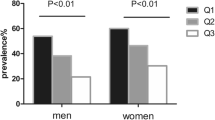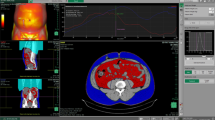Abstract
Background
Although nonalcoholic fatty liver disease (NAFLD) is associated with visceral obesity, the relationship between visceral fat accumulation and skeletal muscle steatosis in patients with NAFLD has not been established. We evaluated: (1) the relationship between multifidus muscular tissue steatosis, visceral fat accumulation, and biochemical data in a cross-sectional study, and (2) the influence of weight reduction on multifidus muscular tissue steatosis in a longitudinal study.
Methods
Three hundred thirty-three NAFLD patients were enrolled. Hepatic steatosis, visceral fat area, and the multifidus muscle/subcutaneous fat attenuation ratio (MM/F ratio) were evaluated by computed tomography. To evaluate how weight reduction produced by diet and exercise affected the MM/F ratio, changes in the MM/F ratio were compared between weight reduction and non-weight reduction groups.
Results
There was a gender difference in MM/F ratios. The MM/F ratio was significantly correlated with age (male r = 0.613, P < 0.01; female r = 0.440, P < 0.01). The MM/F ratio was positively correlated with visceral fat area (male: r = 0.262, P < 0.01; female: r = 0.214, P < 0.01). A decrease in the MM/F ratio, concomitant with reduced visceral fat accumulation, led to alleviation of hepatic steatosis in 20 patients with weight reduction, but not in 22 patients without weight reduction.
Conclusions
The MM/F ratio was closely related to aging and visceral fat accumulation. The MM/F ratio was improved by weight reduction, indicating that fat accumulation in the multifidus muscle evaluated by computed tomography might be a therapeutic indicator of NAFLD.



Similar content being viewed by others
References
Kojima S, Watanabe N, Numata M, Ogawa T, Matsuzaki S. Increase in the prevalence of fatty liver in Japan over the past 12 years: analysis of clinical background. J Gastroenterol. 2003;38:954–61.
Charlton M. Nonalcoholic fatty liver disease: a review of current understanding and future impact. Clin Gastroenterol Hepatol. 2004;2:1048–58.
Eguchi Y, Eguchi T, Mizuta T, Ide Y, Yasutake T, Iwakiri R, et al. Visceral fat accumulation and insulin resistance are important factors in nonalcoholic fatty liver disease. J Gastroenterol. 2006;41:462–9.
Ishibashi E, Eguchi Y, Eguchi T, Matsunobu A, Oza N, Nakashita S, et al. Waist circumference correlates with hepatic fat accumulation in male Japanese patients with non-alcoholic fatty liver disease, but not in females. J Gastroenterol Hepatol. 2008;23:908–13.
Eguchi Y, Mizuta T, Ishibashi E, Kitajima Y, Oza N, Nakashita S, et al. Hepatitis C virus infection enhances insulin resistance induced by visceral fat accumulation. Liver Int. 2009;29:213–20.
Kawaguchi Y, Mizuta T, Oza N, Takahashi H, Ario K, Yoshimura T, et al. Eradication of hepatitis C virus by interferon improves whole-body insulin resistance and hyperinsulinaemia in patients with chronic hepatitis C. Liver Int. 2009;29:871–7.
Heydrick SJ, Jullien D, Gautier N, Tanti JF, Giorgetti S, Obberghen EV, et al. Defect in skeletal muscle phosphatidylinositol-3-kinase in obese insulin-resistant mice. J Clin Invest. 1993;91:1358–66.
Simoneau JA, Colberg SR, Thaete FL, Kelley DE. Skeletal muscle glycolytic and oxidative enzyme capacities are determinants of insulin sensitivity and muscle composition in obese women. FASEB J. 1995;9:273–8.
Goodpaster BH, Thaete FZ, Simoneau JA, Kelley DE. Subcutaneous abdominal fat and thigh muscle composition predict insulin sensitivity independently of visceral fat. Diabetes. 1997;46:1579–85.
Goodpaster BH, Theriault R, Watkins SC, Kelley DE. Intramuscular lipid content is increased in obesity and decreased by weight loss. Metabolism. 2000;49:467–72.
Saadeh S, Younossi ZM, Remer EM, Gramlich T, Ong JP, Hurley M, et al. The utility of radiological imaging in nonalcoholic fatty liver disease. Gastroenterology. 2002;123:745–50.
Haffner SM, Kennedy E, Gonzalez C, Stern MP, Miettinen H. A prospective analysis of the HOMA model. The Mexico City Diabetes Study. Diabetes Care. 1996;19:1138–41.
Katz A, Nambi SS, Mather K, Baron AD, Follmann DA, Sullivan G, et al. Quantitative insulin sensitivity check index: a simple, accurate method for assessing insulin sensitivity in humans. J Clin Endocrinol Metab. 2000;85:2402–10.
Matteoni CA, Younossi ZM, Gramlich T, Boparai N, Liu YC, McCullough AJ. Nonalcoholic fatty liver disease: a spectrum of clinical and pathological severity. Gastroenterology. 1999;116:1413–9.
Brunt EM, Janney CG, Di Bisceglie AM, Neuschwander-Tetri BA, Bacon BR. Nonalcoholic steatohepatitis: a proposal for grading and staging the histological lesions. Am J Gastroenterorol. 2000;95:1370–1.
Piekarski J, Goldberg HI, Royal SA, Axel L, Moss AA. Difference between liver and spleen CT number in the normal adult: its usefulness in predicting the presence of diffuse liver disease. Radiology. 1980;137:727–9.
Yoshizumi T, Nakamura T, Yamane M, Waliul Isulam AHM, Menju M, Yamasaki K, et al. Abdominal fat: standardized technique for measurement at CT. Radiology. 1999;211:283–6.
Torriani M, Hadigan C, Jensen ME, Grinspoon S. Psoas muscle attenuation measurement with computed tomography indicates intramuscular fat accumulation in patients with the HIV-lipodystrophy syndrome. J Appl Physiol. 2003;95:1005–10.
Visser M, Kritchevsky SB, Goodpaster BH, Newman AB, Nevitt M, Stamm E, et al. Leg muscle mass and composition in relation to lower extremity performance in men and women aged 70 to 79: the health, aging and body composition study. J Am Geriatr Soc. 2002;50:897–904.
Tamura Y, Tanaka Y, Sato F, Choi JB, Watada H, Niwa M, et al. Effects of diet and exercise on muscle and liver intracellular lipid contents and insulin sensitivity in type 2 diabetic patients. J Clin Endocrinol Metab. 2005;90:3191–6.
Thomas EL, Brynes AE, Hamilton G, Patel N, Spong A, Goldin RD, et al. Effect of nutritional counselling on hepatic, muscle and adipose tissue fat content and distribution in non-alcoholic fatty liver disease. World J Gastroenterol. 2006;12:5813–9.
Sinha R, Dufour S, Petersen KF, LeBon V, Enoksson S, Ma YZ, et al. Assessment of skeletal muscle triglyceride content by (1) H nuclear magnetic resonance spectroscopy in lean and obese adolescents: relationships to insulin sensitivity, total body fat, and central adiposity. Diabetes. 2002;51:1022–7.
Kim CS, Nam JY, Park JS, Kim DM, Yoon SJ, Ahn CW, et al. The correlation between insulin resistance and the visceral fat to skeletal muscle ratio in middle-aged women. Yonsei Med J. 2004;45:469–78.
Acknowledgments
The authors would like to thank all the medical staff at Eguchi Hospital, Yukie Watanabe, Chieko Ogawa, and Reiko Sonoda for their assistance and Professor Kyuichi Tanikawa (International Institute for Liver Research) for his excellent advice.
Author information
Authors and Affiliations
Corresponding author
Rights and permissions
About this article
Cite this article
Kitajima, Y., Eguchi, Y., Ishibashi, E. et al. Age-related fat deposition in multifidus muscle could be a marker for nonalcoholic fatty liver disease. J Gastroenterol 45, 218–224 (2010). https://doi.org/10.1007/s00535-009-0147-2
Received:
Accepted:
Published:
Issue Date:
DOI: https://doi.org/10.1007/s00535-009-0147-2




